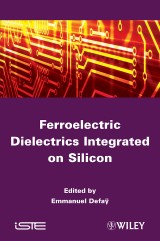Details

Ferroelectric Dielectrics Integrated on Silicon
1. Aufl.
|
192,99 € |
|
| Verlag: | Wiley |
| Format: | EPUB |
| Veröffentl.: | 07.02.2013 |
| ISBN/EAN: | 9781118602805 |
| Sprache: | englisch |
| Anzahl Seiten: | 448 |
DRM-geschütztes eBook, Sie benötigen z.B. Adobe Digital Editions und eine Adobe ID zum Lesen.
Beschreibungen
This book describes up-to-date technology applied to high-K materials for More Than Moore applications, i.e. microsystems applied to microelectronics core technologies.<br /> After detailing the basic thermodynamic theory applied to high-K dielectrics thin films including extrinsic effects, this book emphasizes the specificity of thin films. Deposition and patterning technologies are then presented. A whole chapter is dedicated to the major role played in the field by X-Ray Diffraction characterization, and other characterization techniques are also described such as Radio frequency characterization. An in-depth study of the influence of leakage currents is performed together with reliability discussion. Three applicative chapters cover integrated capacitors, variables capacitors and ferroelectric memories. The final chapter deals with a reasonably new research field, multiferroic thin films.
<p><b>Chapter 1. The Thermodynamic Approach 1</b><br /> <i>Emmanuel DEFAŸ</i></p> <p>1.1. Background 1</p> <p>1.2. The functions of state 2</p> <p>1.3. Linear equations, piezoelectricity 6</p> <p>1.4. Nonlinear equations, electrostriction 8</p> <p>1.5. Thermodynamic modeling of the ferroelectric–paraelectric phase transition 9</p> <p>1.6. Conclusion 24</p> <p>1.7. Bibliography 25</p> <p><b>Chapter 2. Stress Effect on Thin Films 27</b><br /> <i>Pierre-Eymeric JANOLIN</i></p> <p>2.1. Introduction 27</p> <p>2.2. Modeling the system under consideration 27</p> <p>2.3. Temperature–misfit strain phase diagrams for monodomain films 28</p> <p>2.4. Domain stability map 35</p> <p>2.5. Temperature–misfit strain phase diagram for polydomain films 48</p> <p>2.6. Discussion of the nature of the “misfit strain” 50</p> <p>2.7. Conclusion 52</p> <p>2.8. Experimental validation of phase diagrams: state of the art 52</p> <p>2.9. Case study 53</p> <p>2.10. Results 53</p> <p>2.11. Comparison between the experimental data and the temperature–misfit strain phase diagrams 60</p> <p>2.12. Conclusion 65</p> <p>2.13. Bibliography 66</p> <p><b>Chapter 3. Deposition and Patterning Technologies 71</b><br /> <i>Chrystel DEGUET, Gwenaël LE RHUN, Bertrand VILQUIN and Emmanuel DEFAŸ</i></p> <p>3.1. Deposition method 71</p> <p>3.2. Etching 86</p> <p>3.3. Contamination 86</p> <p>3.4. Monocrystalline thin-film transfer 87</p> <p>3.5. Design of experiments 96</p> <p>3.6. Conclusion 107</p> <p>3.7. Bibliography 108</p> <p><b>Chapter 4. Analysis Through X-ray Diffraction of Polycrystalline Thin Films 111</b><br /> <i>Patrice GERGAUD</i></p> <p>4.1. Introduction 111</p> <p>4.2. Some reminders of x-ray diffraction and crystallography 112</p> <p>4.3. Application to powder or polycrystalline thin-films 122</p> <p>4.4. Phase analysis by X-ray diffraction 126</p> <p>4.5. Identification of coherent domain sizes of diffraction and micro-strains 132</p> <p>4.6. Identification of crystallographic textures by X-ray diffraction 139</p> <p>4.7. Determination of strains/stresses by X-ray diffraction 146</p> <p>4.8. Bibliography 156</p> <p><b>Chapter 5. Physicochemical and Electrical Characterization 159</b><br /> <i>Gwenaël LE RHUN, Brahim DKHIL and Pascale GEMEINER</i></p> <p>5.1. Introduction 159</p> <p>5.2. Useful characterization techniques 159</p> <p>5.3. Ferroelectric measurement 170</p> <p>5.4. Dielectric measurement 177</p> <p>5.5. Bibliography 180</p> <p><b>Chapter 6. Radio-Frequency Characterization 183</b><br /> <i>Thierry LACREVAZ</i></p> <p>6.1. Introduction 183</p> <p>6.2. Notions and basic concepts associated with HF 184</p> <p>6.3. Frequency analysis: HF characterization of materials 204</p> <p>6.4. Bibliography 211</p> <p><b>Chapter 7. Leakage Currents in PZT Capacitors 213</b><br /> <i>Emilien BOUYSSOU</i></p> <p>7.1. Introduction 213</p> <p>7.2. Leakage current in metal/insulator/metal structures 215</p> <p>7.3. Problem of leakage current measurement 225</p> <p>7.4. Characterization of the relaxation current 233</p> <p>7.5. Literature review of true leakage current in PZT 237</p> <p>7.6. Dynamic characterization of true leakage current: I(t, T) 239</p> <p>7.7. Static characterization of the true leakage current: I(V,T) 263</p> <p>7.8. Conclusion 273</p> <p>7.9. Bibliography 275</p> <p><b>Chapter 8. Integrated Capacitors 281</b><br /> <i>Emmanuel DEFAŸ</i></p> <p>8.1. Introduction 281</p> <p>8.2. Potentiality of perovskites for RF devices: permittivity and losses 283</p> <p>8.3. Bi-dielectric capacitors with high linearity 294</p> <p>8.4. STO capacitors integrated on CMOS substrate by AIC technology 298</p> <p>8.5. Bibliography 303</p> <p><b>Chapter 9. Reliability of PZT Capacitors 305</b><br /> <i>Emilien BOUYSSOU</i></p> <p>9.1. Introduction 305</p> <p>9.2. Accelerated aging of metal/insulator/metal structures 307</p> <p>9.3. Accelerated aging of PZT capacitors through CVS tests 316</p> <p>9.4. Lifetime extrapolation of PZT capacitors 325</p> <p>9.5. Conclusion 335</p> <p>9.6. Bibliography 336</p> <p><b>Chapter 10. Ferroelectric Tunable Capacitors 341</b><br /> <i>Benoit GUIGUES</i></p> <p>10.1. Introduction 341</p> <p>10.2. Overview of the tunable capacitors 342</p> <p>10.3. Types of actual tunable capacitors 355</p> <p>10.4. Toward new tunable capacitors 366</p> <p>10.5. Bibliography 375</p> <p><b>Chapter 11. FRAM Ferroelectric Memories: Basic Operations, Limitations, Innovations and Applications 379</b><br /> <i>Christophe MULLER</i></p> <p>11.1. Taxonomy of non-volatile memories 379</p> <p>11.2. FRAM memories: basic operations and limitations 383</p> <p>11.3. Technologies available in 2011 387</p> <p>11.4. Technological innovations 388</p> <p>11.5. Some application areas of FRAM technology 394</p> <p>11.6. Conclusion 396</p> <p>11.7. Bibliography 397</p> <p><b>Chapter 12. Integration of Multiferroic BiFeO3 Thin Films into Modern Microelectronics 403</b><br /> <i>Xiaohong ZHU</i></p> <p>12.1. Introduction 403</p> <p>12.2. Preparation methods 407</p> <p>12.3. Ferroelectricity and magnetism 416</p> <p>12.4. Device applications 427</p> <p>12.5. Bibliography 436</p> <p>List of Authors 443</p> <p>Index 445</p>
<p><strong>Emmanuel Defaÿ</strong> has been involved at CEA LETI Minatec in piezoelectric and High-K dielectrics for 15 years. He has published 70 scientific papers, one book on piezoelectrics and worked with several top level microelectronics manufacturers (IBM, Freescale, ST). He is currently a lecturer at Ecole Centrale Paris and By-Fellow of Churchill College, Cambridge University, UK.


















